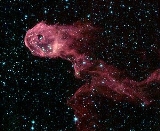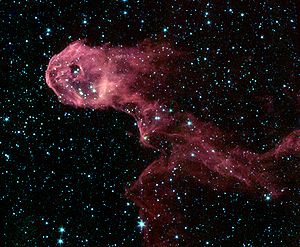
Elephant's Trunk nebula
Encyclopedia

Cepheus (constellation)
Cepheus is a constellation in the northern sky. It is named after Cepheus, King of Aethiopia in Greek mythology. It was one of the 48 constellations listed by the 2nd century astronomer Ptolemy, and remains one of the 88 modern constellations.-Stars:...
about 2,400 light years away from Earth. The
piece of the nebula
Nebula
A nebula is an interstellar cloud of dust, hydrogen gas, helium gas and other ionized gases...
shown here is the dark, dense globule IC 1396A; it is commonly
called the Elephant's Trunk nebula because of its appearance at visible light wavelengths,
where there is a dark patch with a bright, sinuous rim. The bright rim is the surface of
the dense cloud that is being illuminated and ionized by a very bright, massive star that
is just to the west of IC 1396A. (In the Figure above, the massive star is just to the left
of the edge of the image.) The entire IC 1396 region is ionized by the massive star,
except for dense globules that can protect themselves from the star's harsh ultraviolet
rays.
The Elephant's Trunk nebula is now thought to be a site of star formation,
containing several very young (less than 100,000 yr) stars that were discovered
in infrared images in 2003. Two older (but still young, a couple of million years,
by the standards of star
Star
A star is a massive, luminous sphere of plasma held together by gravity. At the end of its lifetime, a star can also contain a proportion of degenerate matter. The nearest star to Earth is the Sun, which is the source of most of the energy on Earth...
s, which live for billions of years) stars are present in
a small, circular cavity in the head of the globule. Winds from these young stars
may have emptied the cavity.
The combined action of the light from the massive star ionizing and compressing
the rim of the cloud, and the wind from the young stars shifting gas from the center
outward lead to very high compression in the Elephant's Trunk nebula. This pressure
has triggered the current generation of protostars.
External links
- Capturing the Stars, Astrophotography by the Masters IC 1396A. Telegraph.co.uk. Retrieved 2010-10-13
- Elephant's Trunk Nebula in IC1396 Paul Beskeen Astrophotography. Retrieved 2010-10-13
- IC 1396 in Mapped Color 17 August 2004. Russell Croman Astrophotography. Retrieved 2010-10-13

